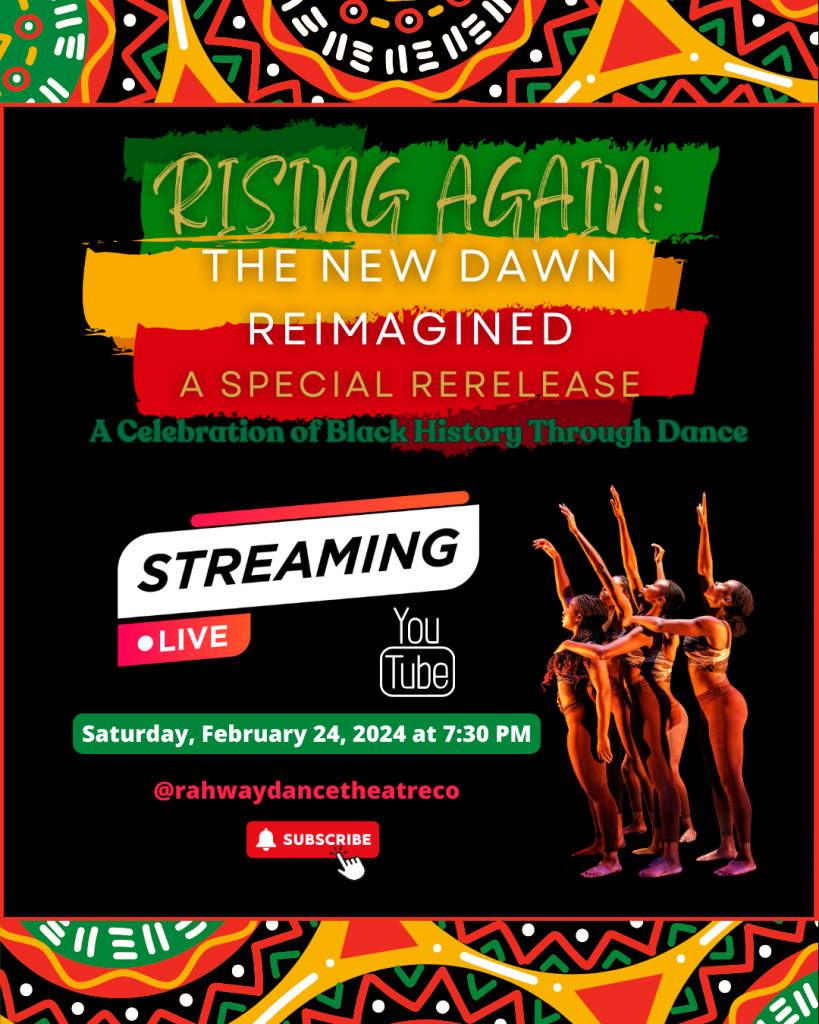February is a time to celebrate and honor the rich tapestry of Black history, culture, and achievements. Black History Month provides an opportunity to reflect on the remarkable contributions of Black individuals who have shaped our world in countless ways. At Rahway Dance Theatre, we embrace this month as a moment to amplify the voices and stories that have often been overlooked. Through dance, we honor the resilience, creativity, and vibrant spirit of the Black community. Join us in a month-long celebration of diversity, unity, and the enduring power of dance to tell stories that transcend time and inspire us all.
1. Katherine Dunham (1909-2006):
Katherine Dunham, a dance luminary, played a pivotal role in transforming the landscape of dance. She pioneered anthropological dance, seamlessly blending African and Caribbean styles, creating a unique and vibrant fusion. Beyond her groundbreaking choreography, Dunham left an indelible mark by founding her own dance company, providing a platform for diverse talents to shine. Her influence extended far beyond her time, shaping the realms of modern and jazz dance, and leaving an enduring legacy that continues to inspire dancers worldwide.
2. Josephine Baker (1906-1975):
Josephine Baker, a pioneering figure, introduced daring performances in Europe that captivated audiences with her charisma and talent. Beyond the stage, she emerged as an iconic figure in the French Resistance during World War II, using her influence to support the fight against oppression. Committed to justice, she advocated for civil rights, leaving an enduring legacy that extends far beyond the realm of entertainment.
3. Bill “Bojangles” Robinson (1878-1949):
Bill “Bojangles” Robinson, a tap dance legend, holds a significant place in history as the first Black performer to star in a major Hollywood film. His rhythmic and innovative tap dance style left an indelible mark, inspiring generations of tap dancers to come. Robinson’s contributions not only broke barriers but also paved the way for greater recognition of Black talent in the entertainment industry. His legacy continues to resonate, reminding us of the enduring power of dance to transcend boundaries and leave an impact that lasts for generations.
4. Arthur Mitchell (1938-2018):
Arthur Mitchell holds a significant place in dance history as the first Black principal dancer at New York City Ballet. His groundbreaking achievements extended beyond his role as a dancer; he co-founded the Dance Theatre of Harlem, an institution that became a powerhouse in the world of dance. Mitchell’s influence extended beyond his own performances, as he championed diversity in ballet, breaking down barriers and inspiring generations of dancers to come. His legacy is one of talent, leadership, and a commitment to making ballet an inclusive art form.
5. Misty Copeland (b. 1982):
Misty Copeland stands as a trailblazer in the world of ballet, making history as the first Black female principal dancer at the American Ballet Theatre. Her incredible journey has not only broken barriers but has become a beacon of inspiration for young dancers around the world. Through her grace, strength, and dedication, Misty has reshaped the landscape of classical ballet, leaving an indelible mark on the art form and encouraging a new generation to dream without limits.
6. Raven Wilkinson (b. 1976):
Raven Wilkinson stands as a trailblazer in the world of ballet, achieving the remarkable feat of becoming the first Black ballerina to debut a leading role in Swan Lake with a major ballet company. Her groundbreaking accomplishment shattered racial stereotypes within the ballet world, opening doors for future generations of dancers of color. Raven’s resilience, talent, and determination have left an indelible mark, inspiring a more inclusive and diverse landscape in the beautiful art form of ballet.
7. Debbie Allen (b. 1950):
Debbie Allen is a highly acclaimed choreographer, director, and actress, celebrated for her groundbreaking contributions to both television and film. With an impressive career spanning decades, she has received numerous awards for her innovative work and has left an indelible mark on the world of dance and entertainment. Allen’s creativity and passion have inspired countless individuals, making her a trailblazer in the industry.
8. Judith Jamison (b. 1943):
Judith Jamison, a celebrated dancer and the artistic director of the Alvin Ailey American Dance Theater, played a pivotal role in preserving and elevating the legacy of Alvin Ailey. Her remarkable contributions include not only her exceptional talents as a dancer but also her dedication to ensuring that Ailey’s vision thrived and continued to inspire audiences around the world. As a respected leader in the dance world, Jamison’s impact on the Alvin Ailey American Dance Theater remains enduring and significant.
9. Gregory Hines (1944-2003):
Gregory Hines, a true tap dance master, left an indelible mark on the world of performing arts. Renowned for his dazzling footwork, he graced both film and Broadway stages, becoming a star celebrated for his unique contributions to tap dance. His innovative choreography set a new standard, and his collaborations with fellow artists showcased the magic that happens when creativity knows no bounds. Gregory Hines remains an inspiration, his legacy echoing in the rhythmic beats of tap dancers following in his iconic footsteps.

10. Jay Skeete-Lee (1965-2020):
June Mary Skeete-Lee was born in London, England. She came to the US many years ago and lived in Brooklyn, NY and Kansas before coming to Rahway. Mrs. Lee was the owner of the Rahway Dance Theatre, Rahway, NJ, for over 30 years where she was a highly respected dance instructor and recipient of many awards including the “Women Who Rock” award for her contributions and impact on dance. She was also recognized by the International Myeloma Foundation (IMF) for her efforts in fighting the disease.
You’re Invited: We’re celebrating Black dancers throughout American history who made it possible for us to connect movement and technique to spirit of our beginnings in Africa. We rejoice in the bravery of these pioneers who took the artistic risks that bring us to what dance looks like worldwide today.











